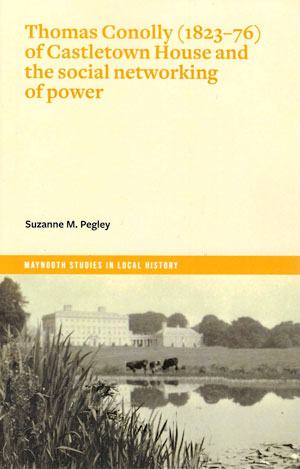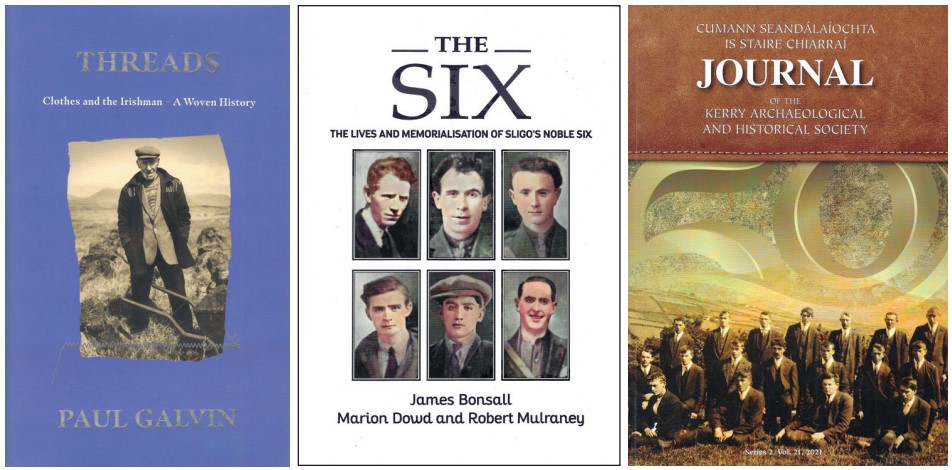BOOKWORM
Published in Book Reviews, Book Reviews, Issue 1 (January/February 2023), Volume 31By Joe Culley
@TheRealCulls
It is late 1864 and the American Civil War rages towards its conclusion. General Sherman and his troops are marching through Georgia to convince the inhabitants of the error of their ways. And so it is that Thomas Conolly, Irish MP, ruminating on affairs at his demesne in Castletown House, Co. Kildare, decides that the best thing is for him to take ship, cross the Atlantic and run the Union maritime blockade to support the Confederacy.
So begins the most exceptional adventure in Suzanne M. Pegley’s Thomas Conolly (1823–76) of Castletown House and the social networking of power. Unsurprisingly, Conolly’s plans did not run smoothly. His initial choice of transport, a smallish steamship, was incapable of transatlantic travel, but after a stop in Madeira, a change of ship and another pleasant stop in Bermuda, Conolly eventually arrived in Raleigh, North Carolina. He had with him all of his many trunks of luggage and accoutrements, and, of course, his horse.
In the following weeks Connolly, in between constant socialising with the attractive belles, would move to Richmond just before the Confederate capital was overrun. The stereotypically garrulous Irishman would dine with President Jefferson Davis and review the troops beside General James Longstreet. Then, as the city collapsed into chaos, he managed to bribe a boatman to get him across the Potomac to safety.
Remarkably, this adventure is not the focus of Pegley’s study. Instead, she is interested in the networks of power of the time. She examines how Conolly ‘moved from space to space engaging in the social rituals that connected the elites within the wider social and political arenas’. These spaces included parliament in London, the gentlemen’s clubs there and in Dublin, and Castletown itself, the ‘most important Palladian house in Ireland’.
In many ways Conolly was unremarkable. He left no impression as an MP, but he was a bit of a boyo, highly sociable, a talented huntsman, a frequent client of ‘women of the demi-monde’, and counted among his friends Napoleon III and his son. Significantly, like many of his peers he was also forever heavily, if quietly, in debt, and not long before his early death—almost certainly from venereal disease—he took out two large life insurance policies.
Happily, Pegley’s study is one of six in the new tranche of the Maynooth Studies in Local History series from Four Courts Press. Prof. Michael Potterton has taken over from founder and long-time editor Raymond Gillespie. And there have been other changes, including the cover design and, more interestingly, length. Previously each issue was 64 pages, whereas these range from 50 to 100 pages.
In her entertaining contribution to the series, Regina Donlon, a lecturer at Carlow College, St Patrick’s, outlines the story behind The burning of Knockcroghery village, Co. Roscommon, 1921. The village, just north of Athlone on the western shore of Lough Ree, was, even at this time, renowned as a centre for the manufacture of clay pipes—quite literally a cottage industry at which most of the inhabitants were employed.
In June 1921, weeks away from the Truce, the officer in command of the British forces based in Athlone, Col.-Commandant Thomas Lambert, was ambushed and killed while returning from a night out socialising in Glasson, on the other side of the lake. For reasons that Donlon explains, however, Knockcroghery became the target of the reprisal. The culprits, probably drunk, arrived in the village by army tender but dressed in civilian clothes. They torched the place, and only the three buildings with slate roofs survived. No more clay pipes.
Trinity professor Rachel Moss and Glenstal monk Colmán Ó Clabaigh have collaborated on the excellent ‘Modest and civil people’: religion and society in medieval Galway. Probably the most telling or formative aspect of that pretty western town is that its inhabitants quite happily identified as English and believed that they were surrounded by, in ecclesiastical terms, heretical Gaels. In particular, they didn’t want their clergy to be appointed by the local Cistercians, and in 1385 they petitioned the pope to change the system. In the end, they had to wait exactly 100 years until Pope Innocent VIII established a ‘wardenship’ system which left them independent of the local bishop. These new vicars were to celebrate the Eucharist according to ‘English decency’, the better to ‘serve the parishioners of St Nicholas, “modest and civil people who live surrounded by walls, not following the customs of the mountainous and wild people of those parts”’. There is also much fascinating detail about the enormous influence that the local burghers, such as the Lynch family, had over the centuries on the workings of the church.
In the other three Maynooth series issues, Tudor historian David Heffernan focuses on north-west Cork in Early modern Duhallow, c. 1534–1641: the crisis, decline and fall of Irish lordship; public health nurse Lisa McGeeney makes an important survey of Nursing and midwifery in the poor-law unions of Borrisokane and Nenagh, 1882–1922; and retired Kildare engineer John Colgan follows, in part, a DNA trail to learn more about Nathaniel Colgan, 1851–1919: the life, times and genealogy of an enigmatic Dubliner. Colgan (no relation to the author) had little formal education yet became an eminent botanist known for his research on the ‘real’ shamrock and for his encyclopaedic survey The flora of the county Dublin. He was made a member of the Royal Irish Academy.
Threads, by former Kerry football-star-turned-fashion-designer Paul Galvin, has an interesting premise: to tell the stories of men who inspired his collections to see ‘how history is woven into the clothes Irishmen wear’. Instead, it is an admittedly stylish marketing exercise dressed up (pun intended) in that dread miasma that is ‘storytelling’. But, I hear you ask, what is the quality of the history? Well, that seems to depend on the quality of the Google search. I stopped reading after the chapter on Samuel Beckett (yes, Sam inspired a collection; did you know he played cricket?—yes, I know you did) in which we encounter ‘Finnegan’s Wake’ (sic) and learn that Estragon is ‘one of only two characters’ in Godot. One shouldn’t hold an author responsible for such lapses, but one can certainly glare at the publisher.
Exactly a year ago we reviewed Even the heather bled by Sligo historian Joe McGowan about the infamous killing atop a mountain of six IRA Volunteers in the Civil War. Now comes the more detailed and, especially, more intimate The six: the lives and memorialisation of Sligo’s noble six, which delves deeply into the lives of these young men and examines how their stories captured the local imagination. And the first thing you learn is that the killings, which were famously conducted atop Benbulben, didn’t happen on Benbulben at all. For more information you can follow the story on Twitter @TheSix_Sligo.
The 50th printed edition of the Kerry Archaeological and Historical Society’s Journal takes time out to celebrate the remarkable scholarship of its contributors over the years. And there is an interesting piece by Aoibheann Lambe on the recent explosion of new discoveries of ancient ‘rock art’ in the county: the number of panels discovered has doubled since 2014.
Suzanne M. Pegley, Thomas Conolly (1823–76) of Castletown House and the social networking of power (Four Courts Press, €11.65 pb, 100pp, ISBN 9781801510349).
Regina Donlon, The burning of Knockcroghery village, Co. Roscommon, 1921 (Four Courts Press, €11.65 pb, 64pp, ISBN 9781801510301).
Rachel Moss and Colmán Ó Clabaigh OSB, ‘Modest and civil people’: religion and society in medieval Galway (Four Courts Press, €11.65 pb, 72pp, ISBN 9781801510288).
David Heffernan, Early modern Duhallow, c. 1534–1641: the crisis, decline and fall of Irish lordship (Four Courts Press, €11.65 pb, 88pp, ISBN 9781801510295).
Lisa McGeeney, Nursing and midwifery in the poor-law unions of Borrisokane and Nenagh, 1882–1922 (Four Courts Press, €11.65 pb, 72pp, ISBN 9781801510325).
John Colgan, Nathaniel Colgan, 1851–1919: the life, times and genealogy of an enigmatic Dubliner (Four Courts Press, €11.65 pb, 54pp, ISBN 9781801510332).
Paul Galvin, Threads: clothes and the Irishman—a woven history (Gill Books, €22.99 hb, 352pp, ISBN 9780717192823).
James Bonsall, Marion Dowd and Robert Mulraney, The six: the lives and memorialisation of Sligo’s noble six (Glencar Press, €30 pb, 270pp, ISBN 9781739139605).
Tony Bergin (ed.), Journal of the Kerry Archaeological and Historical Society (2nd ser.) Vol. 21 (Kerry Archaeological and Historical Society, €20 pb [free to members], 130pp, ISBN 9781739837754).



















